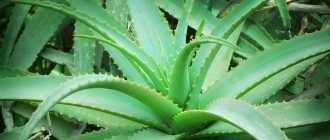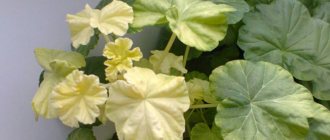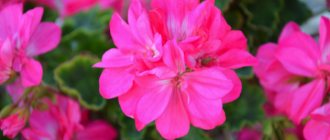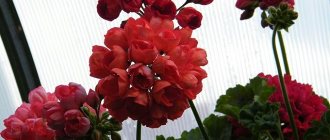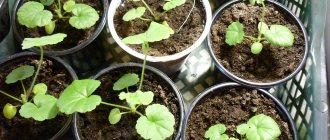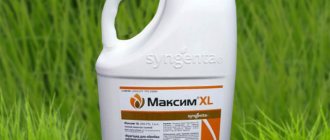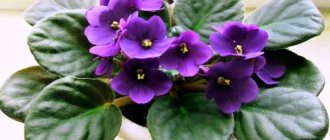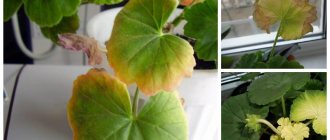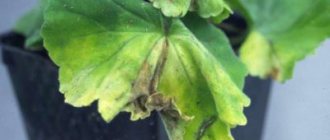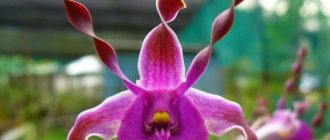What kind of houseplant is this?
Geranium is a flower that is very popular among gardeners. It is sure to be in the collection of an aristocrat or on the windowsill of an elderly person. Nowadays the interest in it is not the same as before, but people still appreciate it for its many advantages.
Reference. Geraniums are credited with healing properties. It can even protect against insect pests.
It grows well at home or in the garden. Numerous varieties and varieties have been discovered, thereby giving the right of choice to everyone who wants to acquire a pot of it. She has great potential in medicine.
We recommend that you read our other articles on how to care for geraniums:
- houses in pots;
- a house plant in winter;
- in open ground.
In culture[edit | edit code]
Floral diagram of the variety "Ann Thomson": 5 free sepals, 5 free petals, 10 free fertile stamens, top
ovary
, consisting of five fused
carpels
, style with five stigmas
In Europe, geranium was introduced into cultivation in the 17th century; in Russia it appeared at the beginning of the 18th century and became widespread at the beginning of the 19th century, when Russian botanists began actively studying the flora of the Caucasus[11].
Species common in cultivation and resistant to climatic conditions in central Russia:
- Tall geraniums (reaching a height of 50 cm or more) Geranium palustre
- Swamp geranium - Geranium ×magnificum
- Magnificent geranium - Geranium ibericum
- Georgian geranium - Geranium phaeum
- Red-brown geranium - Geranium sanguineum
- Blood red geranium - Geranium sylvaticum
- Forest geranium - Geranium pratense
- Meadow geranium - Geranium psilostemon
- Small-stamened geranium, or Armenian - Geranium
platypetalum
Geranium endressii
- Geranium himalayense
- Himalayan geranium, or large-flowered geranium
- Dalmatian geranium
macrorrhizum
Geranium cinereum
- Renard's geranium
- Robert's Geranium
The above species, with the exception of Geranium Roberta, can grow in one place without dividing and replanting for 8-15 years. Signs of aging (death of the middle of the bush) begin to appear at 6-7 years.
Flowering time
(for central Russia):
- Flowers bloom at the end of May, flowering lasts 20-30 days: Geranium large-rhizome, Himalayan, red-brown, forest.
- Flowers bloom in mid-June, flowering 40-45 days: Geranium small-stamened, Georgian, Endrisa, flat-petaled, Roberta, blood-red.
- Flowers bloom in early July, flowering 30-40 days: Magnificent geranium, marsh, Dalmatian, Renarda, meadow.
- Flowers bloom at the end of July, flowering 30-40 days: Ash geranium.
Types of geraniums with beautiful (yellow or reddish) color of autumn foliage: Robert's geranium, Georgian, flat-petaled, large-rhizomatous, small-stamened. Evergreen species: Blood-red, red-brown geranium.
Photophilous species:
Geranium magnificent, Himalayan, Georgian, Dalmatian, Endrisa, small-stamened, large-rhizome, Renarda, flat-petaled.
Shade-tolerant species
: Blood-red, meadow, marsh geranium.
Shade-loving species
: Red-brown geranium, Roberta, forest.
Drought-resistant species
: Dalmatian geranium, ashy, Renarda, large-rhizome.
The soil
: loose, well-drained, fertile. Most species grow on acidic, slightly acidic and neutral soils. Calciphiles: Blood-red geranium, Dalmatian, ashy, Endris, Renard[5].
Some varieties of hybrid origin[edit | edit code]
- 'Patricia'
- 'Nimbus'
- 'Brookside'
- 'Ann Folkard'
Soil value
Why can’t you replant pelargonium into the first substrate you come across on the counter in a flower shop? The fact is that the fate of the plant depends on the composition of the soil , whether it will bloom at home or not.
- Turf. It is rich in nutrients that are so necessary for the growth of indoor plants: palm, dracaena, monstera, ficus.
- Leaf soil. It is obtained in a simple way: in the fall, leaves are collected and placed in a stack. In the summer they constantly spill it with water, not forgetting to shovel it at least twice. Even after 2-3 years, begonias, cyclamens, camellias, myrtle, etc. are planted in it.
- Peat is a mandatory mixture to increase soil acidity. It is collected from the swamp, placed in a stack, and shoveled from time to time to eliminate harmful substances.
- Heather soil , it is harvested from heather thickets, and then added to pots with azaleas, orchids, gloxinias, etc.
Types of begonia
Begonia can be divided into two main types:
- blooming,
- deciduous.
This means that some types of begonias do not bloom at home; they are bred for their gorgeous, large leaves with bright, rich colors.
The leaves attract attention due to the interesting veins that have contrasting colors in some species.
Flowering begonia species delight owners with beautiful panicles with branches. Flowers can be double or smooth and have different shades.
There is a difference in caring for deciduous and flowering begonias: flowering ones require feeding. And deciduous ones are often more unpretentious and can grow in the most difficult lighting conditions.
What soil composition is needed?
Geranium is a plant that is not picky about soil. But you shouldn’t buy just any one. It is advisable to follow certain recommendations when selecting it. So, what kind of soil should this houseplant be planted in?
Most often, gardeners buy universal soil, adding the necessary components to it . Vermiculite, river sand and perlite are suitable. All components are mixed and then poured into a pot of geranium. The main thing is to make sure that there is no mold or insects in the soil.
Reference. The flower grows well in loose and well-drained soil. You can buy special soil at a flower shop or prepare the substrate yourself.
Sometimes peat is added to the universal soil, which promotes the growth and development of the crop.
Favorite soil for indoor geraniums: we prepare it ourselves or choose it in the store
Geranium is a delicate houseplant that, due to its unpretentiousness, deserves high popularity among housewives. But, as with other plants, there are some nuances for proper care, ensuring growth and development. One of the most important aspects is choosing the right mixture for geraniums. In this article we will talk about the advantages and disadvantages of different mixtures, so you can choose whether to make it yourself or buy it in a store.
Choosing the right soil for flowers
In order for indoor geranium to grow as a strong plant with beautiful and bright flowers, you need to choose the right soil (read about the features of growing geranium in a pot here). Selecting suitable soil will relieve the plant from severe stress during replanting, help it easily adapt and establish itself in a new place, and ensure bright flowering (how to replant geraniums?). Properly selected soil is also the key to plant health.
The best option for geraniums is a mixture with a loose texture combined with high-quality drainage.
Indicators when choosing the right mixture for geraniums:
- fertility and nutrition;
- slightly acidic or neutral soil composition.
- soil saturated with beneficial microorganisms;
- the correct mechanical composition of the soil, on which air permeability depends.
What soil composition is needed?
The correct mixture for geranium should have a good mechanical composition. To determine it, you can take a handful of soil, moisten it well with water and hold it tightly in your fist. A high-quality base for planting geraniums will crumble, and a poor one will remain in the fist in the form of a dense lump.
What soil base does geranium like? Here are some variations in the composition of the mixture.
- Chernozem. This soil is loved by almost all plants and is widely available in specialized stores. You can put expanded clay at the bottom of the pot, and cover it with black soil on top (which pot is needed and how to choose?)
Combine chernozem with a mixture of sand and perlite. This will ensure the soil is light and breathable. Before filling the container with soil mixture, small crushed stone or expanded clay is poured onto the bottom.
A purchased mixture that is designed specifically for geraniums. Such mixtures contain all the components and beneficial substances intended specifically for the growth and development of the geranium flower.
The correct soil composition includes equal parts of turf and leaf soil, humus, sand and peat. Turf soil is a storehouse of nutrients that promote plant growth. Leaf soil is obtained from dry leaves, which are watered abundantly during the winter period, and also shoveled about 2 times per season.
For geraniums, horse, cow or bird humus is suitable. Promotes increased growth and flowering. Sand gives the soil water permeability and moisture permeability to the soil, and peat provides acidity to the soil.
How to prepare a mixture for planting at home?
To be sure of the correct composition for geraniums, the correct mixture can be prepared at home. To do this, you should take black soil and disinfect it, that is, heat it in a frying pan for an hour. After this procedure, the soil must be left for up to 2 weeks so that the microcomposition of the soil has time to recover. Then the components are added to the soil in a ratio of 8:2:1
Prices and description of the finished product
Below is an overview of the mixtures that can be purchased in the store.
"BIUD" "Flower Palisade"
This soil has a high amount of elements that contain nutrients , allowing home plants to fully grow and develop. However, it has no restrictions on its use.
Compound:
Nutrient composition:
- nitrogen, not less than 0.2%;
- phosphorus, not less than 0.1%;
- potassium, not less than 0.1%;
- calcium, not less than 0.1%.
The price of this soil varies from 100 rubles to 170 rubles, depending on the volume of packaging.
"Gardens of Babylon"
The soil is a mixture of nutrients and microelements , suitable for planting garden and house plants, ensuring full growth and flowering.
Compound:
- peat: high and lowland;
- river sand with a coarse-grained structure;
- expanded clay;
- dolomite flour;
- expanded vermiculite;
- compost "BUID".
Nutrient composition:
- nitrogen up to 0.9%;
- phosphorus up to 0.4%;
- calcium up to 0.3%;
- potassium up to 0.4%;
- water up to 53%.
The price of this soil varies from 70 rubles to 170 rubles, depending on the volume of packaging.
"Garden of Miracles"
This soil has an increased amount of nutrients . Suitable for growing home flowers and garden flowers. The soil is neutral.
Compound:
- high peat;
- river sand;
- fertilizers of mineral origin;
- vermicompost.
Nutrient composition based on mg/l:
- nitrogen-200;
- phosphorus-250;
- potassium-350;
- salt suspension up to 6.5.
The price of this soil varies from 55 to 125 rubles.
"Greenworld"
This soil is suitable for growing home and balcony flowers . It has a high content of nutrients, stimulates the growth and development of the plant, its flowering. It should also be noted that the presented soil is suitable for growing a winter garden and growing plants on terraces.
Compound:
- high-moor, low-lying peat;
- alumina;
- crushed limestone.
Composition of nutrients based on mg/l 1:
- nitrogen up to 300;
- phosphorus up to 280;
- potassium up to 350;
- microelements up to 6.5.
The price reaches 1000 rubles.
Watering and fertilizing
- Watering. Like all plants, geranium loves water. Especially in the hot summer period, watering is done once a day; in winter, the number of waterings can be limited so that the soil in the pot remains slightly moist, once every 2 days (how to care for geraniums in winter?).
It should be noted that for geraniums it is better if the mixture is almost dry rather than overfilled with water, as there is a risk of gray mold and rotting.
Feeding. Fertilizer for geraniums is a common fertilizer that can be found in any specialty store. The feeding should contain: microelements, nitrogen, phosphorus, potassium, calcium (read about how and what to feed geraniums for abundant flowering here).
Feed geraniums in the evening when the sun has set. Before fertilizing geraniums with fertilizer, be sure to water the plant with water. Do not apply fertilizers that are in a liquid state if the soil is dry.
Selecting the right soil is the first stage in growing a strong and beautiful plant like geranium. Proper care will allow the plant to grow and develop, and following simple rules will enable the plant to delight you for more than one day.
Preparing the substrate for planting a flower
- Before preparing the land, select a container. You can use a pot that has been used. In this case, wash it the day before the scheduled procedure and disinfect it.
- At the next stage, a drainage layer is placed in the pot. It is sold in the store. In principle, you don’t have to buy it, but use pebbles, polystyrene foam, ceramic shards or broken bricks for drainage. If in the future they will water with hard tap water, put pieces of dried pine bark at the bottom. It will acidify the soil and remove excess moisture from it.
- 1/5-1/4 of the pot’s volume is allocated to the drainage layer. Then they put the soil. If you prepare it yourself, take the following components: turf, humus, sand (8:2:1). It is advisable to sprinkle it after transshipment of the transplanted plant, trying to remove all voids.
- All that remains is to water the geranium with settled water and wait for the excess to drain into the pan.
Choosing the right pot
Geranium is a flower that is successfully grown in warm countries directly in garden beds. In southern countries the climate is favorable, and therefore it is a large spreading bush with a woody trunk. In the northern part of Russia, the plant is not planted in open ground. They grow it in a container on the windowsill, but is any suitable for this purpose?
Experienced gardeners do not see the difference between a clay, ceramic or plastic container. You can choose it based on your own preferences. If you take plastic, then only white so that it does not get too hot in the sun and the roots do not rot. A ceramic pot is also suitable for transplanting geraniums. Its volume depends on the pelargonium variety. A small sprout is grown in a 0.25 mm container, gradually increasing it. By 2-3 years, the plant should “migrate” to a 2-liter pot.
Zonal pelargonium is planted immediately in a 1.5-liter pot. As soon as she grows out of it, it is better to transplant her immediately into a 10-liter one.
Read about how to choose and what kind of pot you need for geraniums in our material.
Botanical description[edit | edit code]
The leaves are petiolate, dissected very differently, palmate or palmately lobed, rarely pinnate with three to five leaflets. The leaves of many species are soft-hairy.
Peduncles with one to three flowers. The flowers are regular, large and beautiful, from a five-leafed outstretched calyx and five identical almost round corolla petals, also outstretched almost flat; Their color is white, purple, blue and violet in different shades. There are ten stamens, usually all with anthers.
Fruits of the plant Geranium viscosissimum
The fruit is a modified capsule with preserved sepals - a sterigma, which opens from the bottom to the top [10].
How to replant?
Geraniums are replanted when the root system grows strongly , when the flower is flooded and in the absence of buds. It is advisable to replant in the fall, before the plant enters the dormant stage. If you carry out the procedure in the spring, then only before its active growth.
- Before transplanting, prepare a tool (watering can, knife) and a pot. When using an old container, treat it with a chlorine-containing substance and then rinse it with water afterwards.
- Prepare high-quality drainage, positioning it so that ¼-1/5 of the pot is occupied.
- The geranium is taken out of the previous container, being careful not to damage the earthen ball. You can use a knife carefully if you need to separate the soil from the walls.
- After removing the geranium, inspect the roots, trying not to miss any traces of rot or strange spots. If they are present, remove them with scissors.
- Transfer the plant to a new pot, filling all the voids in it with soil.
- After watering, put the pelargonium in the shade for 7 days.
- After seven days, they place it on the windowsill, where there will be no bright light, drafts or heat from heating devices.
- Fertilizing is applied for the first time 2 months after transplantation.
Varieties of geranium
Forest geranium grows in the wild.
Real geraniums have differences from indoor plants; they live in open ground and easily tolerate winter. Popular colors of geraniums are white, purple, blue and violet. The main types of geranium found in Russia:
meadow;
swamp;
blood;
Central European;
Southern European.
The special shape of the seeds determined the name of these plants. It resembles the head of a crane, and the Latin name “geranium” corresponds to it. Therefore, in everyday life among domestic gardeners and abroad, the plant is called crane grass.
The number of species, including not only flowers, but also herbs and subshrubs, is about 400 varieties worldwide. And pelargonium-geraniums, native to South Africa, number about 200 species. Garden varieties of geraniums are widely used for growing in flower beds or in the country. The most popular ones for growing at home are white and pink geraniums.
There are many varieties of fragrant geranium, some with the scent of lemon, wormwood, and almond. But plants with a pleasant aroma have one drawback - a small number of dull flowers. But their leaves are beautiful and large.
White geranium is most popular among indoor plant lovers.
White geranium is beautiful and unpretentious to growing conditions. The most popular and world-famous variety is Royal. Other types of white are destiny (translated as fate or destiny). The flower is a small shrub with a woody shoot, reaching a height of just over half a meter. Its leaves are large, with jagged edges; the flowers are bright, up to 5 cm in size. One stalk can have up to 20 flowers with 5 petals.
A beautiful and popular plant is rose geranium. Pink, red and white are varieties of pelargonium domesticum, only different in color. Plants are often single-shoot, with beautiful velvety leaves and bright flowers. The most beautiful varieties of this species are rightfully considered Symphony and the large-flowered variety Enzette Perle. It is distinguished by long and abundant flowering, subject to simple care rules.
Watering and fertilizing
It is advisable to water geraniums abundantly and regularly. If you overfill it, water stagnation will occur, which will have a detrimental effect on the roots. Good drainage, prepared according to the scheme above, keeps the soil moist without stagnation.
The plant is not fed immediately after transplantation . After two months, the geranium is fertilized without using fresh organic fertilizers. Non-blooming geraniums are fertilized with standard fertilizer, and those with buds are fertilized with special fertilizers. The frequency of fertilizing is 2 times a month.
Read more about what is best to feed and when to use fertilizers for geraniums here, and from this material you will learn how to properly use iodine with hydrogen peroxide to feed the plant.

